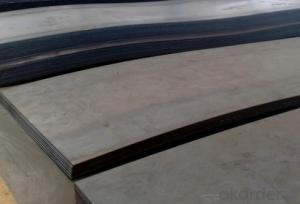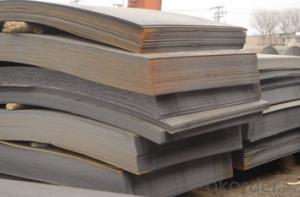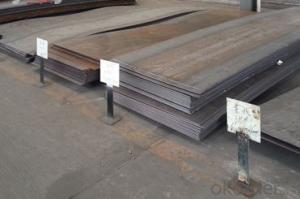Hot Rolled Carbon Steel Plate,Carbon Steel Sheet Q235C, CNBM
- Loading Port:
- Qingdao
- Payment Terms:
- TT OR LC
- Min Order Qty:
- 10 pc
- Supply Capability:
- 30 pc/month
OKorder Service Pledge
OKorder Financial Service
You Might Also Like
Quick Details
| Standard: | AISI, ASTM, GB, JIS | Grade: | Q195,Q235,Q345,A36,C45 | Thickness: | 1.0-30MM |
| Model Number: | Q235,Q195,Q345 | ||||
| Type: | Steel Plate | Technique: | Hot Rolled | Surface Treatment: | Coated |
| Application: | Ship Plate | Special Use: | Silicon Steel | Width: | 30-2000mm |
| Length: | as your requirement | standard: | hot rolled | Surface: | Anti-rust oil |
Packaging & Delivery
| Packaging Details: | seaworthy packages or as customers' require |
| Delivery Detail: | within 15 days after the advance payment |
Hot rolled steel plate
1 carbon steel plate 3mm thick General information
| Product name | Type | Specification | Implementation of GB | ||
| thick | wide | long | |||
| Carbon structural steel | Q195,Q215, Q235A,Q235B, Q235C,Q255, Q275 | 4-120 | 1500-4500 | 6000-12000 | GB/T700-2006 |
| Low-alloy structural steel | Q295,Q345A, Q345B,Q2345C | 4-120 | 1500-4500 | 6000-12000 | BG/T1591-1994 |
| Quality carbon structural stee | 30-50 | 4-120 | 1500-4500 | 6000-12000 | BG/T699-1999 |
| Ship steel | CCSA,CCSB | 4-120 | 1500-4500 | 6000-12000 | materials and welding condition |
| CCSAH32,CCSAH36 CCSDH32,CCSDH36 | 4-120 | 1500-4500 | 6000-12000 | materials and welding condition or GB 712-2000 | |
| Boiler steel | 20g,22Mng, 16Mng,19Mng | 4-120 | 1500-4500 | 6000-12000 | GB 713-1997 |
| Pressure vessel steel | 1622Mng,20R, 15MnVR,15MnVNR | 4-120 | 1500-2700 | 6000-12000 | GB 6654-1996 |
| European standard plate
| S235JR,S235J0, S275JR,S275J0, S275JR2,S355JR, S355J0,S355J2 | 4-120 | 1500-4500 | 6000-12000 | EN 10025 |
| Japanese standard plate | SS400,SS400-B | 4-120 | 1500-4500 | 6000-12000 | JIS G3101-2004 |
2 carbon steel plate 3mm thick detail specification
Material:
A283Gr.D/A573Gr.65,A516Gr65,A516Gr70,A284Gr.D
SS400,SS300,CCSB A36,A32,LRA32,LRB,Q235
Q195,Q235,Q345,SS400,ASTM A36,E235B
Thickness: 4mm-120mm
width: 1500mm-4500mm
Length:2-10m ,accordingly
Thickness | 4-120mm |
Width | 1500-4500mm or as custom's request |
Length | 2-12m,as your requirment |
Technique | Cold rolled or hot rolled |
Surface treatment | Bare, galvanized coated or as customer's requirements. |
Standard | ASTM,EN,GB,JIS,GB |
Material | A283Gr.D/A573Gr.65,A516Gr65,A516Gr70,A284Gr.D SS400,SS300,CCSB A36,A32,LRA32,LRB,Q235 Q195,Q235,Q345,SS400,ASTM A36,E235B |
Terms of Payment | L/C or T/T |
Chemical composition | C≤0.004%;Si≤0.030%; Mn ≤0.17%;P≤0.012%; S≤0.010%; Fe balance |
Delivery Detail | within 30days once receive deposite or confirm L/C |
Packing | Standard export packing,or as requirement |
3 carbon steel plate 3mm thick application:
construction,machinery manufacturing, container manufacturing, shipbuilding, bridge construction. Can also be used to manufacture a variety of containers, the furnace shell, furnace plate, bridge and vehicle static steel plate, low alloy steel plate,shipbuilding plate, boiler plate, pressure vessel plate, pattern plate, tractor parts, automobile frame steel plate and welding components
- Q:Steel plate for steel structure, what kind of steel plate is it?
- Carbon steel, low alloy high strength structural steel and high quality carbon structural steel are often used in building engineering.
- Q:What is the typical yield strength of steel sheets?
- The typical yield strength of steel sheets can vary depending on the grade and type of steel being used. However, for mild steel sheets commonly used in construction and manufacturing, the typical yield strength is around 250 megapascals (MPa) or 36,000 pounds per square inch (psi). Higher strength steels, such as high-strength low-alloy (HSLA) steels or advanced high-strength steels (AHSS), can have yield strengths ranging from 300 to 600 MPa (43,500 to 87,000 psi) or even higher. It is important to note that these values are general estimates and specific steel grades may have slightly different yield strengths.
- Q:What are the different methods of joining steel sheets together?
- There are several methods of joining steel sheets together, each with its own advantages and applications. Some of the common methods include: 1. Welding: Welding is a widely used method for joining steel sheets. It involves melting the edges of the sheets and fusing them together using heat. There are different types of welding processes such as arc welding, gas welding, and spot welding, each suited for specific applications. 2. Riveting: Riveting is a mechanical method of joining steel sheets using metal fasteners called rivets. The rivets are inserted through pre-drilled holes in the sheets and then hammered or pressed to secure them in place. Riveting is known for providing strong and durable joints. 3. Bolting: Bolting involves using bolts and nuts to hold steel sheets together. Holes are drilled through the sheets, and then bolts are inserted from one side, with nuts tightened on the other side to secure the joint. Bolting is quick, easy to assemble, and allows for disassembly if needed. 4. Adhesive bonding: Adhesive bonding uses specialized adhesives to join steel sheets together. The adhesive is applied between the surfaces to be joined and forms a strong bond as it cures. This method is commonly used in industries where welding can cause distortion or is not feasible due to the materials involved. 5. Mechanical fastening: Mechanical fasteners like screws, self-tapping screws, or nails can be used to join steel sheets together. These fasteners create a strong connection by penetrating the sheets and holding them in place. Mechanical fastening is relatively quick and doesn't require any specialized equipment. 6. Clinching: Clinching is a cold forming process that involves joining steel sheets by deforming the material without any external heat source. It involves pressing the sheets together and forming a mechanical interlock. Clinching is commonly used in the automotive industry due to its high-speed production capabilities and joint strength. Each method has its own advantages based on factors such as joint strength, ease of assembly, cost, and specific application requirements. The choice of joining method depends on the purpose of the joint, material properties, and environmental conditions the joint will be subjected to.
- Q:What are the standard dimensions for steel sheets?
- The standard dimensions for steel sheets vary depending on the specific type and grade of steel, but commonly used dimensions include 4 feet by 8 feet, 4 feet by 10 feet, and 5 feet by 10 feet.
- Q:Can steel sheets be used for food processing equipment?
- Yes, steel sheets can be used for food processing equipment. Steel is a commonly used material in the food industry due to its durability, corrosion resistance, and ease of cleaning.
- Q:What are the common uses for steel sheets?
- Steel sheets are commonly used in construction for roofing, siding, and structural components. They are also used in manufacturing for automotive parts, appliances, and machinery. Additionally, steel sheets are utilized in the fabrication of storage tanks, shipping containers, and various industrial applications.
- Q:What are the common sizes and thicknesses of steel sheets?
- Common sizes of steel sheets range from 4x8 feet to 5x10 feet, while typical thicknesses vary from 16 gauge (0.0598 inches) to 26 gauge (0.0179 inches). However, it's important to note that steel sheets can be customized to specific sizes and thicknesses based on individual requirements.
- Q:How do steel sheets compare to aluminum sheets in terms of strength?
- Steel sheets are generally stronger than aluminum sheets in terms of strength. Steel has a higher tensile strength and can withstand higher loads and impacts compared to aluminum. However, aluminum sheets are lighter and have better resistance to corrosion, making them suitable for certain applications where weight and corrosion resistance are important factors.
- Q:Are steel sheets available in non-standard sizes?
- Yes, steel sheets are available in non-standard sizes.
- Q:Are the steel sheets suitable for electrical applications?
- Yes, steel sheets are suitable for electrical applications as they have good conductivity and can be easily shaped into desired forms for various electrical components.
1. Manufacturer Overview |
|
|---|---|
| Location | |
| Year Established | |
| Annual Output Value | |
| Main Markets | |
| Company Certifications | |
2. Manufacturer Certificates |
|
|---|---|
| a) Certification Name | |
| Range | |
| Reference | |
| Validity Period | |
3. Manufacturer Capability |
|
|---|---|
| a)Trade Capacity | |
| Nearest Port | |
| Export Percentage | |
| No.of Employees in Trade Department | |
| Language Spoken: | |
| b)Factory Information | |
| Factory Size: | |
| No. of Production Lines | |
| Contract Manufacturing | |
| Product Price Range | |
Send your message to us
Hot Rolled Carbon Steel Plate,Carbon Steel Sheet Q235C, CNBM
- Loading Port:
- Qingdao
- Payment Terms:
- TT OR LC
- Min Order Qty:
- 10 pc
- Supply Capability:
- 30 pc/month
OKorder Service Pledge
OKorder Financial Service
Similar products
New products
Hot products
Related keywords






























